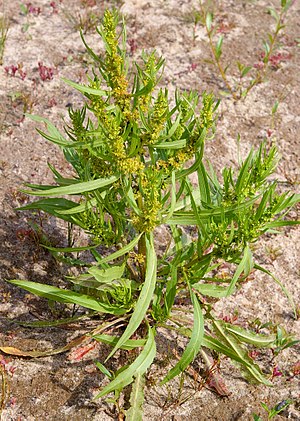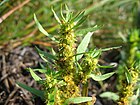Note: This is a project under development. The articles on this wiki are just being initiated and broadly incomplete. You can Help creating new pages.
Rumex maritimus
Rumex maritimus is an erect, unbranched, perennial plant growing 30 - 60cm tall. The plant is harvested from the wild for local use as a food and medicine.
Contents
[hide]- 1 Uses
- 2 Parts Used
- 3 Chemical Composition
- 4 Common names
- 5 Properties
- 6 Habit
- 7 Identification
- 8 List of Ayurvedic medicine in which the herb is used
- 9 Where to get the saplings
- 10 Mode of Propagation
- 11 How to plant/cultivate
- 12 Commonly seen growing in areas
- 13 Photo Gallery
- 14 References
- 15 External Links
Uses
Mild constipation, Skin problems, Diarrhoea, Piles, Bleeding of the lungs, Sores, Ulcers, Wounds, Cancer, Gastric disturbance, Dermatitis.[1]
Parts Used
Chemical Composition
It contains their structures have been established as 3,7,11,15-tetramethyl-n-octadac-13-en-3,4,6,7,8,11-hexol-12-one 1 and 8β-hydroxy-14β-methyl-7-oxopodocarp-5-en-13-(19α-hydroxy- 19,22,22-trimethyl-heptyl)-22-O-(β-D-glucopyranosy 1)-(4-→1) β-D-glucopyranoside 2, respectively, on the basis of chemical and spectral data analysis.[2]
Common names
| Language | Common name |
|---|---|
| Kannada | |
| Hindi | |
| Malayalam | |
| Tamil | |
| Telugu | |
| Marathi | |
| Gujarathi | |
| Punjabi | |
| Kashmiri | |
| Sanskrit | |
| English |
Properties
Reference: Dravya - Substance, Rasa - Taste, Guna - Qualities, Veerya - Potency, Vipaka - Post-digesion effect, Karma - Pharmacological activity, Prabhava - Therepeutics.
Dravya
Rasa
Guna
Veerya
Vipaka
Karma
Prabhava
Habit
Identification
Leaf
| Kind | Shape | Feature |
|---|---|---|
Flower
| Type | Size | Color and composition | Stamen | More information |
|---|---|---|---|---|
| {{{5}}} |
Fruit
| Type | Size | Mass | Appearance | Seeds | More information |
|---|---|---|---|---|---|
Other features
List of Ayurvedic medicine in which the herb is used
Where to get the saplings
Mode of Propagation
How to plant/cultivate
Originally native to tropical Asia and Europe, the plant has spread to become a weed of agriculture throughout much of the world, including higher elevations above 2,200 metres in the tropics.[4]
Commonly seen growing in areas
Grassy places, Waste ground, Roadsides.
Photo Gallery
References
- Jump up ↑ Indian Medicinal Plants by C.P.Khare
- Jump up ↑ Chemical constituents
- Jump up ↑ [Morphology]
- Jump up ↑ Cultivation
External Links
- Ayurvedic Herbs known to be helpful to treat Mild constipation
- Ayurvedic Herbs known to be helpful to treat Skin problems
- Ayurvedic Herbs known to be helpful to treat Diarrhoea
- Ayurvedic Herbs known to be helpful to treat Piles
- Ayurvedic Herbs known to be helpful to treat Bleeding of the lungs
- Ayurvedic Herbs known to be helpful to treat Sores
- Ayurvedic Herbs known to be helpful to treat Ulcers
- Ayurvedic Herbs known to be helpful to treat Wounds
- Ayurvedic Herbs known to be helpful to treat Cancer
- Ayurvedic Herbs known to be helpful to treat Gastric disturbance
- Ayurvedic Herbs known to be helpful to treat Dermatitis
- Herbs with Leaves used in medicine
- Herbs with Stems used in medicine
- Habit - Perennial
- Index of Plants which can be propagated by Seeds
- Herbs that are commonly seen in the region of Grassy places
- Herbs that are commonly seen in the region of Waste ground
- Herbs that are commonly seen in the region of Roadsides
- Herbs





